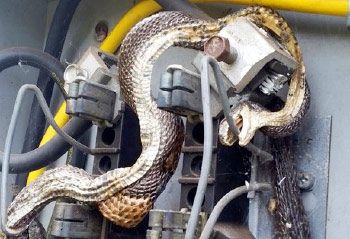Electrical Hazards
Electrical hazards can be found in all industries. Avoiding electrical shocks both at home and at work requires awareness of the hazards and a respect for this “Silent Killer.” The human body has a low resistance to electricity, making it a good conductor, like most metals. Unlike metals however, the human body does not respond well when electricity passes through it. Physical results include thermal burns, disruption of normal heart activity, severe muscle contractions, and even death.

The most common and serious electrical injuries occur when electrical current flows between the hands and feet. This happens when a person touches an energized line. The electrical energy is looking for the shortest path to the ground and it will pass through the body to the feet to reach it. When this occurs, a person’s heart and lungs are frequently damaged by the electrical energy.
Ways to Avoid Electric Hazards:
-
Always inspect tools and equipment for frayed cords and defective plugs before using them;
-
Never use a power tool that has had the ground plug removed–inspect the plug;
-
Never stand in water and operate a power tool without proper (i.e., insulated) footwear;
-
Keep extension cords out of water when in use;
-
Disconnect all electrical tools and cords when not in use;
-
Be sure all temporary lighting is equipped with bulb covers;
-
Make sure all power supplies, circuit boxes and breaker boxes are properly marked to indicate their purpose; and
- Use Ground Fault Interrupters (GFIs) on all jobsites.
Remember, electricity strikes without warning–always play it safe!!
Download flyer: STOTW_336_ElectricalHazards.pdf (292.13 kb)
Download Spanish flyer: STOTW_336_ElectricalHazards_esp.pdf (290.83 kb)

